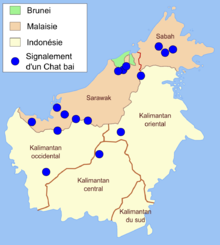
January 13, 2011

Breaking news out of Malaysia is that an extinct felid species has been spotted, leading to speculation that it has been rediscovered. The beautiful cat is one of the smaller wild cats, but the finding of it is no less remarkable than the appearance of other midsized new species.

Ian MacKinnon of The Telegraph in London is reporting that the Bornean Bay Cat, last photographed in 2003 in Lanjak Entimau wildlife sanctuary in southern Sarawak, and declared extinct, has been spotted again.
“Three pictures showing two or three of the Bay Cats were taken [in 2009 and 2010, but just released] in the northern highlands of Sarawak state in Borneo by researchers working for the forestry department,” noted MacKinnon.
The Bornean Bay Cat (Catopuma badia), also known as Bornean Cat, Bornean Red Cat, Bornean Marbled Cat, Borneo-katze, Chat Bai, Gato Rojo de Borneo, Kucing Kalimantan, Kucing Merahor or Bay Cat, is a small feline endemic to the island of Borneo. The Bay Cat and the Asian Golden Cat (Catopuma temminckii) are the only members of the genus Catopuma.
Nearly everything that is known about this cat is based on just twelve specimens, the first of which was collected by Alfred Russel Wallace in 1855 in Sarawak. A total of seven further skins surfaced over the following decades, but it was not until 1992 that a living specimen was obtained, and there were no photographs of the animal until a second living specimen was captured in 1998.

Photo by Jim Sanderson, via Wikipedia.
Despite what the Telegraph says about the cat being “extinct,” the Bay Cat has been only recently reclassified as “endangered” by the IUCN in 2005, after being classified “data deficient” only ten years before. Now that the cat is fully protected over most of its range, CITES has recently placed the Bornean Bay Cat on Appendix II, due to lack of data. There are only fifty known to be left in the world.

Although on paper Borneo has 25 wildlife reserves, only three are actually in existence, with the others only proposed. All of these reserves have been encroached upon by human settlement and logging. Unfortunately local trappers and animal dealers are also well aware that foreign zoos and breeding facilities will pay US $10,000 or more for a live animal. There are no Bay Cats officially in captivity.
About Loren Coleman
Loren Coleman is one of the world’s leading cryptozoologists, some say “the” leading living cryptozoologist. Certainly, he is acknowledged as the current living American researcher and writer who has most popularized cryptozoology in the late 20th and early 21st centuries.
Starting his fieldwork and investigations in 1960, after traveling and trekking extensively in pursuit of cryptozoological mysteries, Coleman began writing to share his experiences in 1969. An honorary member of Ivan T. Sanderson’s Society for the Investigation of the Unexplained in the 1970s, Coleman has been bestowed with similar honorary memberships of the North Idaho College Cryptozoology Club in 1983, and in subsequent years, that of the British Columbia Scientific Cryptozoology Club, CryptoSafari International, and other international organizations. He was also a Life Member and Benefactor of the International Society of Cryptozoology (now-defunct).
Loren Coleman’s daily blog, as a member of the Cryptomundo Team, served as an ongoing avenue of communication for the ever-growing body of cryptozoo news from 2005 through 2013. He returned as an infrequent contributor beginning Halloween week of 2015.
Coleman is the founder in 2003, and current director of the International Cryptozoology Museum in Portland, Maine.
Filed under Alien Big Cats, Breaking News, Coelacanth, CryptoZoo News, Cryptozoology, Extinct, Eyewitness Accounts, Mystery Cats